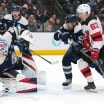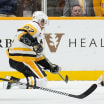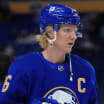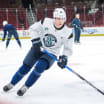The Coaches Room is a weekly column by one of four former NHL coaches and assistants who will turn their critical gaze to the game and explain it through the lens of a teacher. Jim Corsi, David Marcoux, Paul MacLean and Joe Mullen will take turns providing insight.
In this edition, Corsi, the former goaltending coach of the Buffalo Sabres and St. Louis Blues, looks at the change in penalty-killing and a subsequent rise in shorthanded goals this season.
Penalty kills using speed, pressure to disrupt power plays
Corsi says changes in personnel, strategy generating more shorthanded scoring

By
Jim Corsi / Special to NHL.com
I was having supper at an Italian restaurant in Montreal with Columbus Blue Jackets assistant Brad Shaw on Monday. He was in town for a game against the Montreal Canadiens the next night. It was the perfect time to bring up something I've noticed when I break down penalty kills.
I've noticed that penalty kills are featuring faster, more skilled players than previously -- and maybe as a result, more penalty-kill systems are designed to be super-aggressive, leading to more shorthanded opportunities and more shorthanded goals than in the past few seasons.
The penalty kill no longer just features a fearless fourth-line forward. These days, everybody is protected well and players are all blocking shots, so the skill guy can kill penalties and use his speed and timing to pressure the power play into a turnover.
Shaw agreed with me. He is seeing much of the same thing.
The results are telling.
There were 59 shorthanded goals scored through the first 274 games this season, up from 45 through the same number of games last season. The average number of shorthanded goals per game is 0.22, up from 0.15 the past two seasons.
The League is on pace for 273 total shorthanded goals. The average in the past four seasons was 186.
Part of the uptick in shorthanded goals can be traced to the uptick in shorthanded opportunities. There were 1,923 power plays through the first 274 games this season as opposed to 1,792 through that many games last season.
However, the percentages still favor an increase in shorthanded goals. Teams have scored on 3.06 percent of their shorthanded opportunities this season; that number was 2.51 percent through 274 games last season.
The power play used to be a comfort zone. Now it's more like, "Whoa, I can get scored on."
A lot of it is a result of predictability of the power plays, which operate more on scripted, set plays than the organized chaos of 5-on-5. The penalty kill is taking advantage of the scripted power play by dictating the terms more and aggressively pouncing on turnovers.
Right from the get-go, a PK group will go into a 1-1-2 or a 1-3 in the neutral zone, creating difficulty for teams to enter. Teams will attack using a neutral zone drop-pass play or a "deep" double swing for speed. The penalty-kill setup will have the offensive players come up to a wall of defenders.
If the puck carrier is clever enough he might deke one defender, but he won't get by the other one, so then if there is a bad pass it could be a turnover, a counter, and a potential shorthanded breakaway. Teams have figured that out.
What we also see is called a half-ice game. That first forward on the PK will invite that puck carrier to go to one side of the rink or the other. Now he'll have a bunch of people in the middle of the ice that he can't access, so he has to fire it around and then it's a board battle.
That's a great way for the PK to kill time and get an opportunity for a clear or perhaps something better. If it's a board battle, a lot of the time you'll see multiple penalty-killers going toward the puck, leaving a forward in the hash marks, ready to move up if the puck goes up.
Even if the attacking player gets the puck, the most likely thing he'll do is go back up the boards with it. The attacking defenseman on that side is going to try to pinch in, but if the puck gets chipped out, the defending forward who was in the hash marks is now up higher, and all of a sudden he's in a footrace with the defenseman who has to retreat. That could lead to a shorthanded breakaway.
What is basically happening is you have the four penalty-killers inviting the opposition to the least desirable areas.
The addition of the skill and the speed you see on the PK creates pressure on the power play, a little bit of confusion, and now you're set up for counters. Penalty-killers are basically saying, "We know where you're going to end up, and if we can read and anticipate it we have an opportunity to make something of it."
I call it the accordion effect. You have these four penalty-killers and a goalie expanding and compressing in the zone but never losing touch and making great music.
This isn't to say power plays aren't dangerous. They are. In fact, through 274 games played entering Wednesday, power-play percentage on a League-wide basis was at 19.2 percent, up from 17.8 percent through the same number of games last season.
Many power plays often use a shot-first mentality. Success comes from creating organized chaos, as we have seen from 5-on-5 play.
My guess, though, is that the power play percentage of 19.2 percent will dip as the season goes on because there will be more video of the power plays available, more breakdowns, a better understanding of where they want to attack and what areas to take away.
However, if penalty-killers stay aggressive and don't stray out of position, the opportunities to create shorthanded scoring chances will stay consistent, meaning that even if power-play goals drop, special-teams offense won't take a major hit because of the skill on the penalty kill.

















